Growing up, we’ve all found ourselves staring at educational charts that were stuck on the walls of our classrooms. From “domestic animals” and “parts of the body”, to “fruits”, “means of transport”, “trees”, and “birds”, the list of charts goes on. While these charts have withheld the test of time for their value in familiarising young minds with their surroundings, how much of it do children carry on with them, and do our curricula make them care for the environment around them?
This year, as schools across India reopened their gates, Panchayat Union Middle School’s students documented 90 species of birds in Tamil Nadu, submitting 4,316 eBird checklists. This is a huge accomplishment for birders and educators who hope to raise awareness about birdlife within their communities and institutions. The Great Backyard Bird Count (GBBC) is an annual four-day worldwide count held over a long weekend in February. Over the last few years, GBBC has emerged as one of the most awaited birding events in India. Over three days, 3,782 Indian birders from 449 districts recorded 1,017 species, contributing a total of 41,694 checklists in 2022 alone!

On the face of it, these numbers and observations may appear insignificant, but there is a rapidly growing citizen science community that recognises the value of their consistent efforts, especially amongst the youth. Every observation, however small or large, can help scientists across the world in understanding bird populations, their behaviours, and how the environment is changing.
The world is changing rapidly, and we are barely able to keep track of these changes. Science allows us to keep a track of change to some degree, by using satellites, for example… but we can’t keep track of what’s happening on the ground. These changes cannot be left to satellites alone. [Citizens] have to be active participants, and this is where citizen science comes in. It allows citizens to be active participants, instead of passive observers who are only consuming knowledge. In citizen science, [each observation] is actively contributing, if not necessarily to the solution, to some body of knowledge for solving the problem.
—Dr Suhel Quader,
Education and Public Engagement Program,
Nature Conservation Foundation
So what is it that motivates people, especially children, to participate in creating such knowledge? More often than not, our interest in the natural world is generated through wonder and curiosity, sown at a young age. However, given rapid urbanisation, not every child is exposed to nature in close quarters, in their early years. Some reasons for this disconnect can be tied down to the way nature and the environment is taught in classrooms.
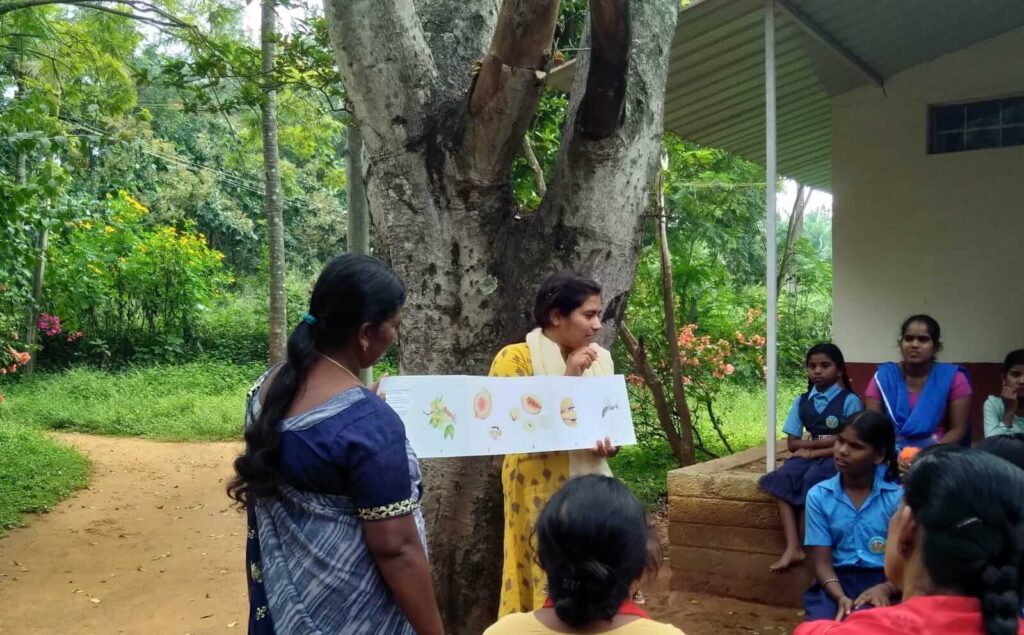
The State of Environmental Education in India
India is one of the few countries where environmental education is compulsory at all levels of formal education. India’s National Policy on Education from as far back as 1986 recognised the centrality of environmental protection and conservation in classrooms, and that “there is a paramount need to create a consciousness of the environment.” It adds that “this needs to permeate across all age groups and sections of society, beginning with children… [Environmental consciousness] will be integrated into the entire educational process”. Since then, several efforts have been made to reorganise school education through the revision of curriculum content and the ‘greening’ of textbooks.
The backdrop of increased attention to environmental consciousness in citizens features a Public Interest Litigation (PIL) filed by M.C. Mehta in the Supreme Court in 1991 to make environmental education compulsory. In response, the SC recognised the need for making environmental education compulsory, which led to its inclusion in the National Curriculum Framework, 2005.
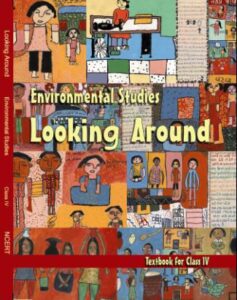
Environmental education also finds repeated mentions in the most recent National Education Policy from 2020, via topics like climate change, pollution, waste management, sanitation, management of biological resources and biodiversity, forest and wildlife conservation, and sustainable development in curricula.
The Ground Reality of Environmental Education
While environmental education has successfully become a part of India’s education framework, it lags on several fronts. “The position paper ‘Habitat and Learning’ associated with Environmental Education Curriculum for Schools that emerged as an aftermath of the National Curriculum Framework of 2005, outlines the curriculum for Environmental Studies with a science-based focus. Its focus is on the uses that humans get out of the environment, what is present in the environment, the way in which we are harming the environment, and the scientific solutions for these issues. Emphasis is on how to stop pollution or how to solve pollution scientifically. So the approach to environmental studies is very science-based in its method and content,” says Mythreyi Kumaraswamy, Project Assistant, Education and Public Management, Nature Conservation Foundation. She further adds that “In reality, [learning about nature] is a combination of science and social studies, because humans are constantly interacting with nature.”
While the curriculum addresses the larger environmental problems we face today, this standardised curriculum fails to address the local environments that children can relate to, which creates a disconnect. While participatory approaches in classroom activities find mention on paper, this often does not translate to on-ground experiences because of scarce access to factual and comprehensive resources, as well inadequate specialised training for Environmental Studies (EVS) teachers.
Often, if you speak to an EVS teacher, they would express that they don’t know enough about the subject or feel underconfident [teaching it]. These are often teachers who have expertise in other subject areas like language or mathematics… EVS is often seen as this in-between subject—it is also science, also social science. You have to be an all rounder to teach this.
—Roshni Ravi, Project Coordinator for the Education and
Public Engagement Program at Nature Conservation Foundation
Another issue with how EVS is taught in schools is the problem-oriented approach that the education framework assumes. Wherein children are often introduced to environmental issues such as pollution early on and this should not be the case since children are not contributors to such pollution. Instead, focusing on instilling care for nature should be encouraged, which develops stewardship values in children as they grow up.
So What Does it Take to Translate Theory into Practice?
Most individuals in environment-related careers will tell you that their experiences with nature sparked their interest early on in their life to explore more professionally. Activities such as birding are not valuable just for recognising species; rather, it is a means to contribute to a larger body of research while inculcating a relationship with the world around them, which is a key aspect of citizen science.
As far as students’ interaction with nature goes, Yuvan Aves, a Chennai-based nature educator and the founder-trustee of Palluyir Trust, suggests that “one’s own self, local landscape, and community as the curriculum.” A child’s understanding of the world is shaped by their parents, surroundings, and school. When the curriculum is not designed to cater to every child, children are unable to establish a connection with their surroundings.
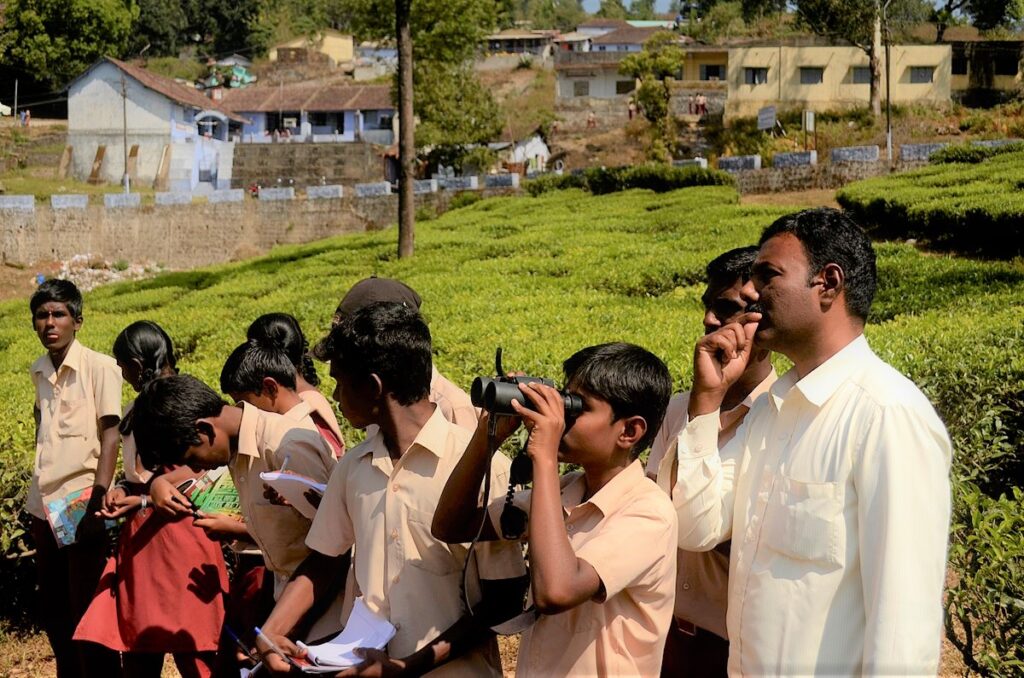
Children have the potential and capacity to learn new concepts, but it requires to be tapped in a sensitive manner. An adaptive teaching pedagogy that considers a child’s varied observations and stimuli in their formative years can be witnessed through nature education initiatives coming to life. These bridge the gaps between theory and praxis, making environmental education an exciting and memorable experience for children across India’s diverse geographies and sociocultural settings.
Introducing Children to Nature in their Classrooms
Engaging children in ecological observations is important to establish a connection with the classroom education they receive. At the Nature Conservation Foundation (NCF), a wildlife conservation and research organisation based in Mysore, a dedicated initiative called Nature Classrooms has been established to include nature learning in EVS across primary schools. Here, lessons for children usually begin with what they already know, after which they move to the unknown.
For instance, in a lesson on how humans keep themselves clean for students between 1-5 years, an element of nature is added, to make the session more interactive. Children are asked questions like “how do animals keep themselves clean?”, or “have you noticed cats licking themselves, or birds preening their feathers?” These are phenomena children observe around them every day, but rarely are they brought into classroom discussions. “It is not a new method or something new the teachers have to learn. It is just the restructuring and rethinking of the approach to a topic, moving from a human-centric view to a biocentric or a nature-centric view. Instead of thinking ‘us and our environment’ we think of it as ‘we are a part of the environment’,” Mythreyi explains.
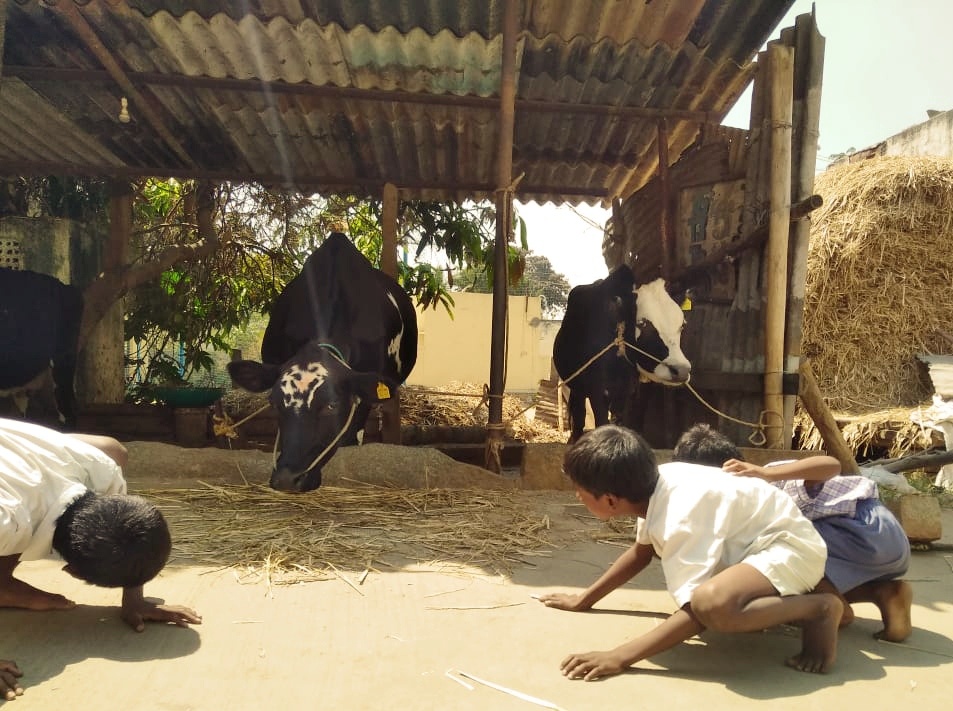
Even the COVID-19 pandemic has put barriers between children and nature. Adapting to the situation, Nature Classrooms’ educators have devised games such as Hidden Housemates through which children can observe nature within their homes, from spiders and their webs, to ants eating sugar, and even floral patterns on curtains!
Another relevant initiative by NCF is called Suttha Muttha, which translates to ‘Our Surroundings’ in Kannada. It aims to build local and context-specific resources for children, a need that was first realised when the team started working with a school in Silvepura in Bengaluru. A peri-urban area, Silvepura is situated in the midst of a changing landscape with expanding agriculture and developmental projects. Children from Northern Karnataka have migrated here with their families and are enrolled in local schools. To ensure that they connect with nature, the resources used in the classrooms had to be locally relevant. Posters on local plants like Giant Milkweed, Singapore Cherry Tree, and the Neem Tree—which were found in this rapidly-changing landscape were created, and teachers involved made sure that existing community knowledge fed into the resource-creation process.
The posters don’t just give facts, but are also an inquiry into nature. We ask children questions such as where have you seen this plant before? What name do you know it by? Is there any way in which this plant is used in your home by your family? The broad goal is to encourage curiosity, and a sense of wonder to begin noticing and paying attention to the things around us in the natural world. You don’t only need to go to a far away forest or ocean, and you don’t need to climb a mountain, to appreciate the wonders of nature around us.
—Roshni Ravi, Nature Conservation Foundation
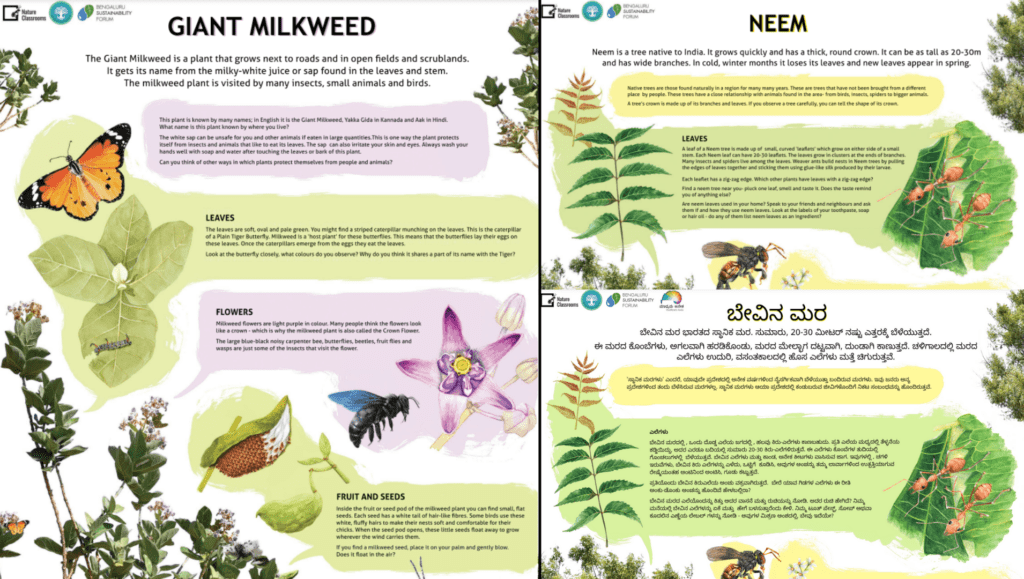
Interventions such as Nature Classrooms and Suttha Muttha are encouraging children to go beyond what’s in their textbooks to see, touch, and hear all that is around them. Several similar interventions have been initiated by nature enthusiasts to promote nature education in India. As these learnings reach classrooms, educators are also reflecting on their experiences. There is a need to develop a language and vocabulary that communicates the essence of natural concepts for educators and researchers. The two terms—’environmental education’ and ‘nature learnings’—are often used interchangeably, but do they mean the same?
“Environmental education is about active engagement with the living world, which we are intrinsically and unextractably a part of. Usually, school systems breed passivity in children by instructing them what to do and what not to do. Such an approach is detrimental to environmental education since it does not focus on active participation… there is a mismatch of values and pedagogy,” says Yuvan.
However, more often than not, people tend to use the terms nature education and environmental education interchangeably. “I don’t think there is a strict taxonomy between the two terms,” says Dr Suhel Quader. The term environmental education does seem to carry a human-centric perspective to it. “It implies an externality as if it is something out there and we are separated from it and studying about it. Whereas, on the contrary, nature [learning] is more intrinsic and visceral,” adds Yuvan.
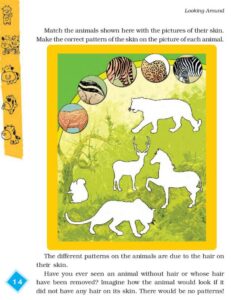
“It is about building positive emotional connections with the natural world around us because humans are wired through emotions and not rational thinking,” Suhel says, as someone who sees environmental education as focusing on solutions to problems, and less on building the will to address the problems in the first place.
Educators are Creating an Environment Conducive to Learning
There are various stages of interventions that teach children about the natural world around them. Designing a curriculum is just the beginning. What is also required is building capacity and capability amongst teachers, creating local and context-specific resources, engaging more directly with nature, and finally, revising existing modes of assessment.
Unless we develop meaningful tools to assess what we are doing [as teachers], we will not get anywhere. If it is just ‘fill in the blank’ or ‘match the following’ kind of questions that require answers to be memorised, then other approaches are not going to fit into that. The resources you use in classrooms, students’ interactions in local surroundings, and their assessment—all of these have to come together. If we not, something is going to fall apart.
—Jane Sahi, Coordinator at The Fig Tree Learning Center, Bengaluru
For the current generation of children to become citizen scientists in the near future, their curiosity towards natural processes needs to be piqued so that their sense of wonder grows within them organically, making them ask questions which need careful answering. Such curiosity can be sown via schools through inclusive and context-specific curricula along with hands-on exposure to directly interacting with their surroundings. Outside of the schools, families and communities can fuel this curiosity by encouraging participation in neighbourhood citizen science opportunities like the Great Backyard Bird Count and nature walks.
The authors would like to extend their gratitude to Ms Vena Kapoor, the
head of NCF’s Nature Classrooms project, for her valuable input in the course of writing this story | Featured image showcasing various nature education activities engaging children courtesy Suttha Muttha, Nature Classrooms and P Jeganathan






